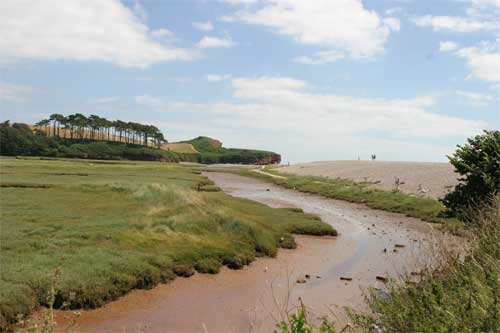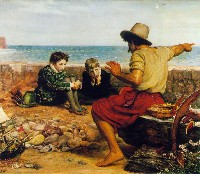
Budleigh Salterton is an attractive town, with a variety of independently owned shops, about 15 miles to the south-east of Exeter nestling on a delightful stretch of the East Devon coastline. It is situated to the west of the mouth of the River Otter, and is the only town within the the East Devon Area of Outstanding Natural Beauty.

The red cliffs form part of the Jurassic Coast World Heritage Site, although much of the geology is Triassic. Its famous smooth bun-like pebbles (or cobbles) on the beach are unusually large for the East Devon area. It is said they were thrown up onto the beach by the Great Storm of 1824, partially blocking the Otter Estuary where they have remained ever since.
In the dry summer of 2006 the clear shallow waters of the Otter flowed gently past the pebble bed to the sea, reaching little more than knee height as I waded across to the foot of the cliffs. As I sat there basking in the heat of the early July sunshine, young children paddled their inflatable dinghies in the wider stretch of river behind the red cliffs.

Budleigh Salterton was established as a seaside resort as long ago as the early 19th century, but today perhaps with some justification it is derided as a genteel backwater, a haven for the frail and elderly to while away their twilight years. In the early 1960s there were thirteen hotels. After the closure of the railway in 1967 many hotels were demolished and replaced by flats. Others became nursing or residential homes.
Now most incomers are pensioners, and in 2004 half the population was over 50 with a third being over 70. East Devon as a whole ranks third in the country in this respect with 30 percent of the population at pensionable age or older according to the 2001 census.
The town is graced with several attractive early 19th century properties, the most well known of which is Fairlynch described in Cherry and Pevsner, The Buildings of England - Devon (1989) as
Fairlynch was opened as a museum in 1967. Today it houses displays of costumes, historical artifacts, and many other things besides.

In 1210 Budleigh Salterton was known as Saltre, which by 1405 had become Salterne, both names stemming from the saltpans used in the Otter estuary. This eventually became Salterton. The town was sometimes known as Ottermouth. Nowadays this refers to the undeveloped area to the east of the town where the River Otter flows into the sea. The reedbeds of the River Otter estuary can be seen behind the pebble bank. This area is a haven for migratory birds and has been accorded Site of Special Scientific Interest status.


Sir Walter Raleigh was born nearby at Hayes Barton, close to the village of East Budleigh. The iconic "The Boyhood of Raleigh" was painted in Budleigh Salterton by Sir John Everet Millais three hundred years after Raleigh's time. It now hangs in London's Tate Gallery (the scan shown is ©Mark Harden ). The second child is Raleigh's friend Humphrey Gilbert.
Associations between Budleigh Salterton and notable literary figures abound, but on close scrutiny some of these links appear to be unfounded.
It is certainly true that in Noel Coward's comedy Blythe Spirit, Elvira Condomine the first wife of the main character Charles Condomine evokes the town's quintessential faded charm when she whinges:
There is also an allusion to the town in Anthony Trollope's novel He Knew He Was Right:
Travel by public transport to Exeter would have been a two-stage journey when the novel was written in 1868. The rail link from Exeter to Exmouth was opened in 1861, and according to Black's Guide to Devonshire (1882), trains from Exeter to Exmouth took 25-30 minutes, with horse-drawn omnibuses running 3 or 4 times a day from Exmouth to Budleigh Salterton taking 50 minutes. The journey time would have been much reduced after the railway link to Budleigh was opened in 1897.
D. St. Leger-Gordon, writing about Devon in 1950 recalls those pre-rail days:
Contrary to what we read in the online tourist guides, Arthur Mee's Devon (1938) tells us it was Anthony's less illustrious brother that lived in the town, though he spent most of his life in Florence:
Many online tourist guides assert that P G Wodehouse is in some way connected to the town, though I cannot find anything to substantiate this: for example, there is no reference to it in the potted biography at the P G Wodehouse Society (UK), nor in the more comprehensive biography in the Oxford Dictionary of National Biographynote1
At the time this article was written, a curious attempt to forge the link was given here:
Unfortunately the author is wrong and so is the spelling of his name! The filming in 1986 at Budleigh Salterton was of Nemesis by Agatha Christie, a mystery in the Miss Marple series, according to IMDb. This source also shows that a film of the P G Wodehouse comedy Heavy Weather starring Peter O'Toole and Richard Briers was made in 1995 in Sudeley Castle, Winchcombe, Gloucestershire, famously the setting for the UK wedding of Elizabeth Hurley and Arun Nayar in March 2007. This later film appears to have no connection with Budleigh Salterton, nor was either book set in this townnote2.
A plausible explanation for the origins of the Budleigh-Wodehouse link is given in the Journal of a Southern Bookreader blog. It transpires that the title of Wodehouse's 1929 story, Unpleasantness at Bludleigh Court has been misnamed in various sources by the dropping of the first 'l'.